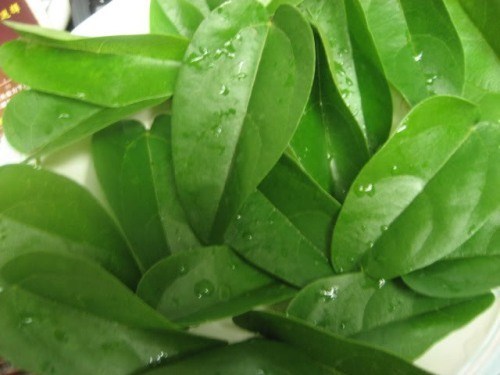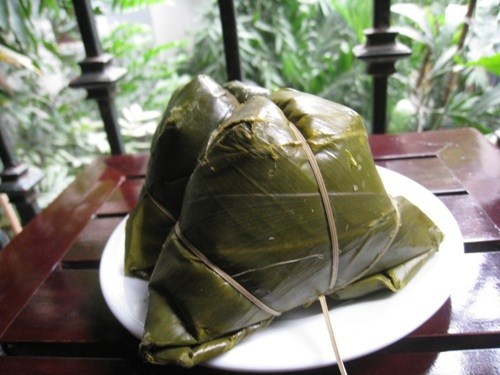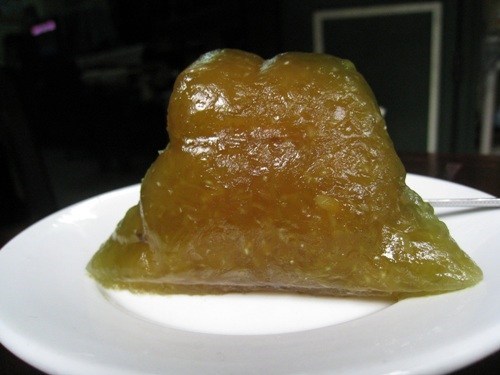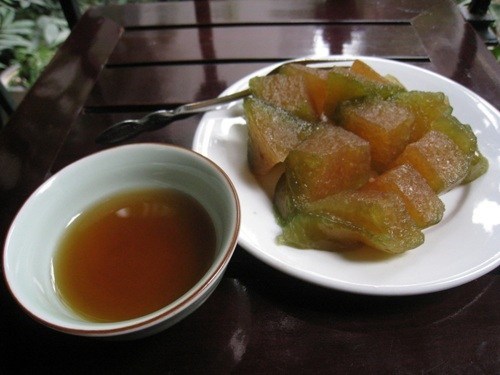“Bánh gio”- Sticky rice cake as beautiful as amber
The taste of the cake mix is that of a cross between the cool of the sticky rice wrapper, the sweet of the molasses and the moisture of the sticky rice with a smell of “lá chít” (sorrel) - which smells lightly of ammonia.
The taste and smell mingle together and create the very typical smell of “Bánh gio”.
The Vietnamese call the half-year celebration of the lunar new year “Tết đoan ngọ” and “Tết giết sâu bọ” means “Tet to kill bugs” because there is a seasonal transition period. During this time agricultural products can be damaged by naturally occurring diseases and bugs, so every year the Vietnamese will take this day to celebrate. On this day people have many traditional customs to control disease. Family members normally wake up early, eat sour fruit, drink rice wine, eat “bánh gio” to kill the bugs and banish the diseases.
“Bánh gio” is a cake made of sticky rice and “gio”. Not just any kind of “gio” and sometimes “tro” can be used instead. It must be a unique type of “gio” made of from the ash of indigo berry leaves or straw husk from sticky rice plants. The “gio” is dissolved in water, awaiting it to drop to the bottom of the pot. The water on top is clear, removed and a glutinous mixture is added to the water until it turns brownish and shiny like amber. A smell like ammonia is very typical of the dish, and can be recognized easily.

In order to have “gio” brown
in color and clear like amber, it takes a lot of time to prepare. In August
sesame is harvested to get the seeds and the rest is burnt to save the ash. It
is dried under the sun then moved to a clean place before burning.
The “gio” is put in a ceramic
jar with the proportion of 30 liters of water to every one kilogram of “gio” with 500 grams of calcium
hydroxide. Once all is dissolved the clean water on the top is removed. This
water will be kept until “Tet đoan ngọ”
to make the cake. One can also use the “gio”
made of the ash of ripe meliaceae fruit or from the straw of sticky rice.
After Tet, meliaceae flowers bloom along the streets turn the
countryside purple. The flowers will fall gradually as summer approaches. The
young green fruits rise in clusters and as they swing in the wind it looks
nice. In December the fruits are ripe and invite birds to come and sing on the
boughs of the trees, bringing happy sounds to the country roads. The ripe fruit
is picked, then dried and burned with the straw of sticky rice, before being
soaked in water to wait for sedimentation.
But if using only “
gio” it is
not enough to get the amber color, so you need to use fresh bamboo shoots that
are grilled and hanged in the kitchen. When making cake we have to strip bamboo
in small fibers then mix it with glutinous rice soaked in the “
gio” water for about five to six hours.
When the rice is hydrated and plump to the point that it feels soft under a
fingernail, it is taken out, mixed with salt and drained.

“Bánh gio” has the best taste
when wrapped with “chít rừng” leaf.
Selected leaves should be fresh, green, large and intact. These leaves should
be boiled many times to remove its strong smell, then dried well before use for
wrapping. Sometimes people use boiled or steamed dong leaves with their veins
stripped to ease wrapping.
The rice is
put into the middle of the leaf then wrapped by folding the edges around the
cake. The cakes should be made of uniform size and have a nice shape so as to
encourage thorough cooking. The cake is made with either a square or long
shape. The cake shouldn’t be tied too tight so that there is room for the rice
to expand as it cooks.

When wrapping the cake it shouldn’t be oily, as it will inhibit the
doneness. The cakes are put together into a pot on a small piece of bamboo so
they do not touch the bottom, and covered with water (which is mixed with a
little bit of “gio” water). The pot
is covered with a basket, and a heavy object is placed atop to ensure the cakes
do not float. The cakes cook approximately five hours. When cooked, they are
removed and dipped into cold water. As they cool they are arranged on a tray
and can be kept approximately two weeks.
“Bánh gio” is only tasty when served with melted molasses. The cake
looks like a gemstone with deep brown color as beautiful as amber, and is
transparent enough so as to look straight through. Cut the cake by chopstick or
the rope used to tie the cake, then enjoy with molasses.
The taste of the cake mix is that of a cross between the cool of the
sticky rice wrapper, the sweet of the molasses and the moisture of the sticky
rice with a smell of “lá chít”
(sorrel) - which smells lightly of ammonia. The taste
and smell mingle together and create the very typical smell of “Bánh gio”.

You can eat “Bánh gio” when
you are either hungry or full because it is very easy to digest and cleanses
the palate of any rich food. According to folk tales it can also treat dysentery.
Every holiday or Tet there are distinctive types of cakes, a uniqueness
of Vietnamese cuisine. Chinese New Year celebrates with “square sticky rice
with pork and green bean in the middle” and “Bánh dày” – Glutinous rice; Cold Food Festival has glutinous rice
dumpling cake; Mid-Autumn Festival has moon cakes and baked dumpling and “Tết đoan ngọ” celebrates with “Bánh gio”.
“Bánh gio” is also called “Bánh
âm”, which means the cake that support for the yin part of the body because
its ingredients are yin-based (the plants, calcium and potassium). According
to Chinese medicine, the human body has the principle of “dương thường hữu dư, âm thường bất túc” which means that people develop diseases because the yin elements in
their body are insufficient, thereby increasing the yang. “Bánh gio” has a flat flavor, is cool and easily digested so it is
good for the elderly, children and women who have chronic flu with fever.

Because of these traditional properties “Bánh gio” is considered a cake that balances body temperature so
people usually eat it on hot days. Because of that “Bánh gio” is selected to be the main dish in “Tết đoan ngọ” when it is the hottest time of the year. This is
supported by the legend of “Tết đoan ngọ”
that originates from China and the legend about Qu Yuan loyal King Huai Wang .
If want to choose an authentic Vietnamese cake besides “Bánh chưng” and “Bánh dày” then choose “Bánh
gio”. “Banh gio” doesn’t belong
to any specific province, but it can be present at any countryside market.
Across three regions of the country there are famous villages that make “Bánh gio”: Dinh Bang Village, Bac Giang
province; the village of Dac So, Hoai Duc, Ha Noi; Tay Dinh, Vinh Phuc
province; Phu Yen, Binh Dinh province; Quang Nam, Yen Lang; Thanh Hoa province.
Although it is just a small cake our hometown and country is contained
within.
Followed by V.H
Dan Tri Newspaper
Extracted from articles written especially
for the 2014 Golden Spoon “A journey of searching traditional rustic dishes.”